Autumn and Everything After……. Designing Beautiful Late Season Gardens with Ornamental Grass…
“Autumn is a Second Spring, When Every Leaf is a Flower” – Camus
 A Grouping of Miscanthus sinensis, ‘Morning Light’, ‘Variegatus’, and Miscanthus ‘Purpurascens’ in Mid-October at Ferncliff
A Grouping of Miscanthus sinensis, ‘Morning Light’, ‘Variegatus’, and Miscanthus ‘Purpurascens’ in Mid-October at Ferncliff
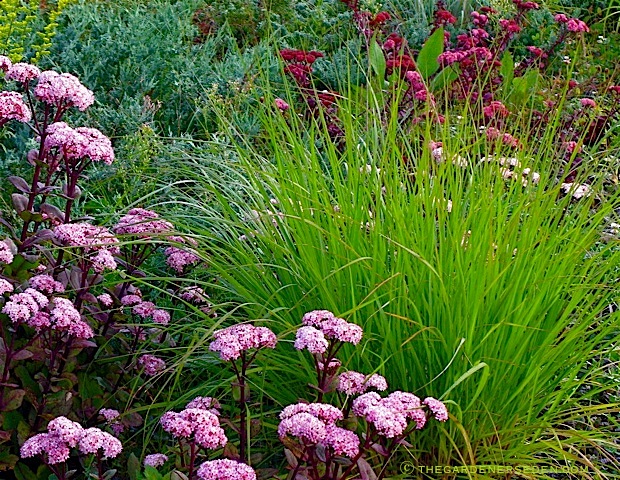 Pennisetum alopecuroides, (fountain grass), with sedum and juniper in the entry garden at Ferncliff  in early September, just before the inflorescence appear.
Pennisetum alopecuroides, (fountain grass), with sedum and juniper in the entry garden at Ferncliff  in early September, just before the inflorescence appear.
Much as I would like summer to drag her feet a bit when departing this year, I find myself looking forward to the brilliant beauty of fall. Living in New England has its benefits, and the months of September, October and November are three of them. Autumn has always been my favorite time of the year, and in no place is my seasonal preference more evident than the garden. As the writer Camus once said, “Autumn is a second spring when every leaf is a flower”. Indeed. I truly savor this second spring, for although I do love the early buds and bulbs of April, pastel hues don’t really excite me. Dark red is my favorite color, and bitter orange, rust, deep violet and burgundy aren’t far behind. The cerulean skies and stained-glass forest canopies of autumn bring a touch of heaven straight to my little paradise on earth. In September and October I feel as if I am living in a paint box, surrounded by a palette of colors so brilliant that simply going for a walk is all the inspiration any artist could hope for.
I cherish the fall gardening season. Some of my most treasured trees, shrubs and perennials reach their peak beauty in autumn. Of the many late-season plants in my garden, the ornamental grasses are high on my list of favorites. Grasses are useful though out the gardening season, of course. Beginning in mid-summer and continuing throughout winter, ornamental grasses provide dramatic foliage, texture and form to my gardens. But come autumn, the shifting hues of foliage and beautifully textured spikes, racemes and panicles of ornamental grass create the potential for a spectacular garden show that can not be beat. By early September, when many perennials and annuals have petered out in the garden, my ornamental grasses are just warming up for their crescendo. As the days shorten and nights cool, chemical changes are triggered in many deciduous trees, shrubs and other plants in the northern areas of the United States. Ornamental grasses also respond to these changes, and many begin to take on subtle tints and vivid hues as dramatic as the trees.
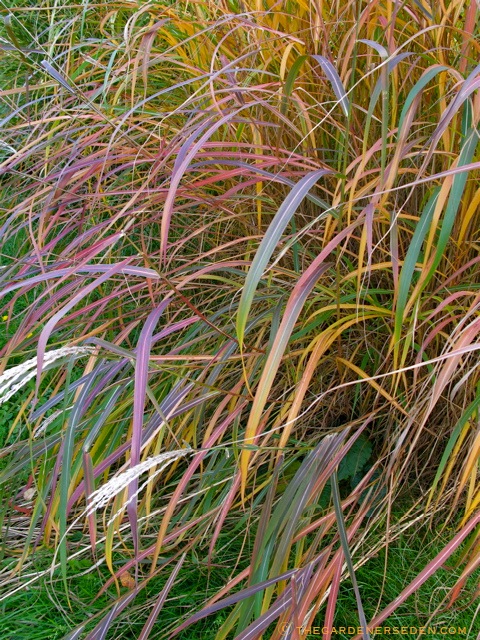 Miscanthus purpurascens, (close up), early fall color, (click to enlarge)
Miscanthus purpurascens, (close up), early fall color, (click to enlarge)
When I design a garden, I try to keep this spectacular late-show in mind. September blooming pepper bush, (Clethera alnifolia, a native shrub I featured here last month), sculptural spice bush, (Lindera benzoin), and and the lovely native paper birch, (Betula papyrifera), all turn brilliant yellow in autumn. I like to combine fall’s seasonal gold foliage with the purple-burgundy-red kaleidoscope-like hues of flame grass, (Miscanthus purpurascens), the brilliant orange of Japanese forest grass, (Hakonechloa macra, cvs. ‘Nicolas’, or burgundy tipped, ‘Beni Kaze’), for example. Witch alder, (Fothergilla gardenii), and many viburnum species, including the arrow wood, (V. dentatum), the American cranberrybush, (V. trilobum), and the European cranberrybush, (V. opulus), turn brilliant shades of red and orange in autumn. This makes them great companions for a wide variety of grasses including switch grass, (Panicum virgatum ‘Heavy metal’, (a blue grass in summer, turning gold in fall), wild oats, (Chasmanthium latifolium), green in summer and red-bronze in fall), and again, flame grass, (Miscanthus pupurascens). Late blooming perennials, such as asters, rudbeckia, mums, sedum and monkshood  all make great companion plants for ornamental grasses.
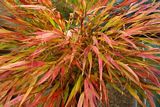 The summer color of Hakonechloa macra ‘Nicolas’,above, intensifies further in autumn
The summer color of Hakonechloa macra ‘Nicolas’,above, intensifies further in autumn
Unless you are a more experienced gardener, companion planting for autumn interest can be a bit difficult. How can you predict color-shifts and texture changes? Nursery tags are often stingy with clues. A good encyclopedia is useful for learning about ornamental grasses and their seasonal changes. And if you know the name of a cultivar, you can easily research information on a web-site such as Dave’s Garden. But for the true ornamental grass aficionado, Rick Darke’s The Color Encyclopedia of Ornamental Grasses (see library) is a great asset. This book will help you to identify more unusual cultivars of sedge, rush, restios, cat-tails and bamboo as well as the gorgeous grasses native to North America and beyond.
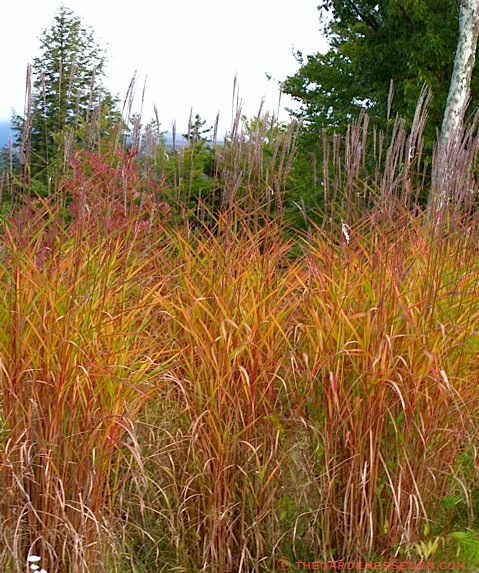 Miscanthus purpurascens, (Flame grass) in late September
Miscanthus purpurascens, (Flame grass) in late September
When I want to add texture and movement in a garden design, no matter the season, I often look to ornamental grass. The larger garden grasses, such as miscanthus, panicum, and calmagrostis, bring important vertical interest and essential structure to perennial gardens. From the fine, delicate foliage and sensual lines of maiden grass, Miscanthus sinensis ‘Morning Light’ to the bold geometric presence of Miscanthus sinensis ‘Gracillimus’, can make a dramatic, sculptural statement in a garden. Grasses can be used to soften modern buildings and camouflage unattractive architecture. A natural choice beside lakes, ponds, streams and pools, grasses also bring a relaxed line to hard-edged water features. Many species of grass are drought tolerant, and a number will survive roadside conditions in even the most inhospitable environments. Alone or as a group, settled into a garden or spilling over a pot, placed at a juncture or to mark a final destination, ornamental grass can provide great focal points in many garden design situations. Ornamental grasses planted en mass can blur the edges of a garden, helping to ease the transition between formal and informal areas. Because of the dramatic stature reached by many large ornamental grasses, they are also very useful as living screens, helping to conceal unsightly necessities such as fuel tanks and air conditioning units. It is easy to understand the growing popularity of this diverse group of plants.
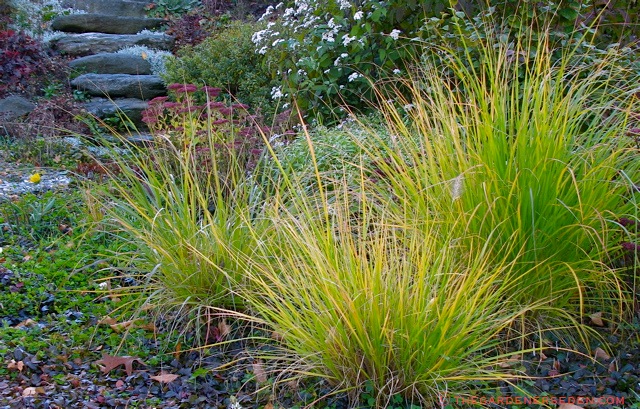 North American native, Bouteloua curtipendula (side-oats grasss), backed by taller Pennisetum alopecuroides in the entry garden at Ferncliff, early September
North American native, Bouteloua curtipendula (side-oats grasss), backed by taller Pennisetum alopecuroides in the entry garden at Ferncliff, early September
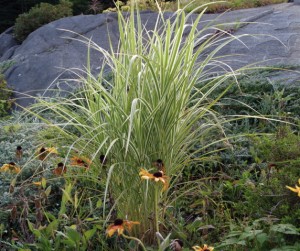 Miscanthus sinensis ‘Variegatus’, here used as a specimen and below, a different cultivar used in a large grouping at the eastern-edge of the garden.
Miscanthus sinensis ‘Variegatus’, here used as a specimen and below, a different cultivar used in a large grouping at the eastern-edge of the garden.
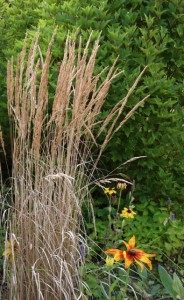 Calamagrostis x acutiflora ‘Karl Foerster’, backed by Viburnum trilobum
Calamagrostis x acutiflora ‘Karl Foerster’, backed by Viburnum trilobum
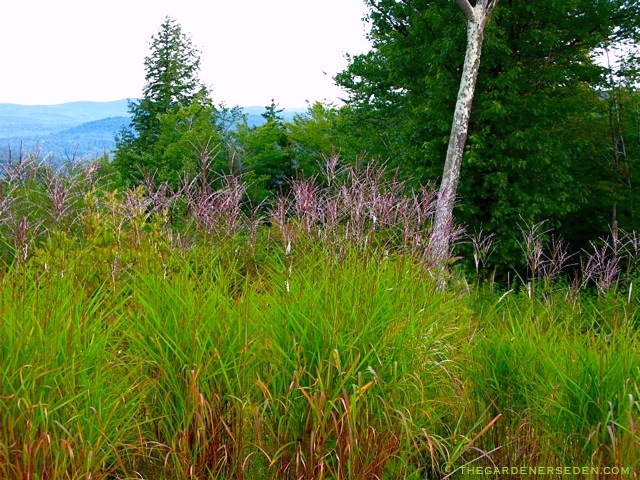 Miscanthus ‘Purpurascens’ grouped at the edge of the northwest meadow in August…
Miscanthus ‘Purpurascens’ grouped at the edge of the northwest meadow in August…
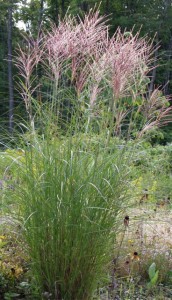 This two year old grass specimen, Miscanthus sinensis ‘Morning light’, catches the early sun as it rises to the east at the edge of the wildflower walk in early September
This two year old grass specimen, Miscanthus sinensis ‘Morning light’, catches the early sun as it rises to the east at the edge of the wildflower walk in early September
Although ornamental grasses have become quite common in sunny perennial gardens, they are still surprisingly overlooked in shade garden designs. This surprises me because grass exists naturally in all but the darkest of shady woodlands, and they can add tremendously to the subtle beauty of low-light gardens. In the shade, I often add fine textured ornamental grass to contrast with larger, broad leafed foliage, such as the leathery, smooth surfaced leaves of hosta. I also like to include bright colored grasses to shade gardens in order to illuminate dark corners and shadowy areas beneath trees. Japanese woodland grass, (Hakonechloa macra), is one of my favorite plants. The golden cultivars, ‘Aureola’ and ‘All-Gold’ are very useful in low light areas, and in contrast to violent-tinted foliage. Newer cultivars, such as ‘Nicolas’ and ‘Ben Kaze’,(mentioned above), are rich in bitter orange and burgundy hues. These are truly spectacular plants with enormous design potential. Sedges are also useful in partial shade. I count orange-hook sedge, (Ucinia egmontiana), among my favorite low-light grasses, although it is marginally hardy in New England, (I usually place it in pots for summer and move them inside for winter). Â Sedges will also tolerate more sunlight, provided they are given ample moisture, and I like to use them in brighter locations as well, (see pots on deck below).
 A close-up of Hakonecholoa macra ‘All Gold’ in the shady Secret Garden at Ferncliff
A close-up of Hakonecholoa macra ‘All Gold’ in the shady Secret Garden at Ferncliff
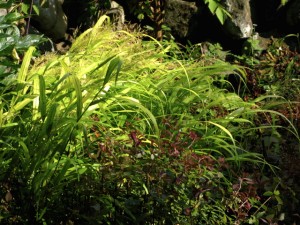 Hakonecholoa macra ‘All-Gold’, (Japanese forest grass), catching the morning light in the Secret Garden at Ferncliff
Hakonecholoa macra ‘All-Gold’, (Japanese forest grass), catching the morning light in the Secret Garden at Ferncliff
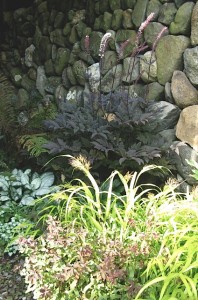 The golden color of this Japanese forest grass brings out the violet hues in the companion plantings of Cimicifuga racemosa ‘Hillside black beauty’ and the young foliage of euphorbia on the left
The golden color of this Japanese forest grass brings out the violet hues in the companion plantings of Cimicifuga racemosa ‘Hillside black beauty’ and the young foliage of euphorbia on the left
Many ornamental grasses also make great potted plants. I particularly like sedge and stipa in massive groupings on decks and terraces, where they catch the slightest breeze. A sedge commonly known as fiber-optic plant, (Isolepis cernua), looks very dramatic in a pot. I like to allow this mop-like grass to spill over the edge of a planter, emphasizing its pendent form. Whenever I set a fiber-optic plant out on a pedestal, it becomes the focus of attention and conversation, like living sculpture. Personally, I have grown a bit tired of cleverly designed, over-planted pots. I prefer simplicity. Over the past few years, I have been limiting my planter-compositions to a few species of plants, and ornamental grasses are often featured in my current designs.
 Stipa tenuissima, (Mexican Feather Grass)
Stipa tenuissima, (Mexican Feather Grass)
 Orange Hook Sedge, (Uncinia egmontiana)
Orange Hook Sedge, (Uncinia egmontiana)
 Pennisetum setaceum ‘Rubrum’ and Stipa tenuissima Catching the Breeze and Afternoon Light
Pennisetum setaceum ‘Rubrum’ and Stipa tenuissima Catching the Breeze and Afternoon Light
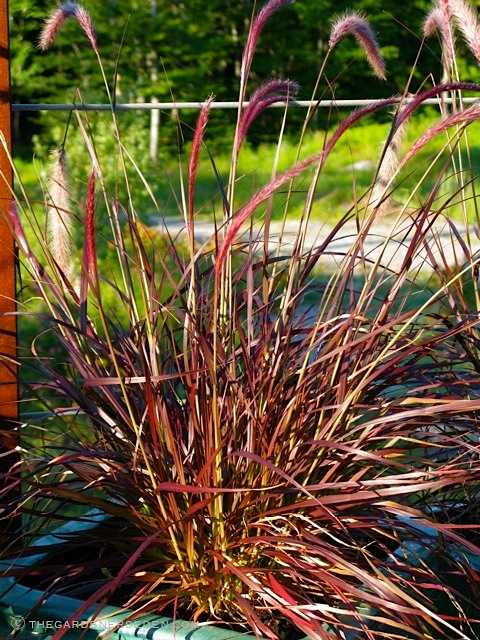 Pennisetum setaceum ‘Rubrum’ up close
Pennisetum setaceum ‘Rubrum’ up close
Like many cold-climate gardeners, I try to enjoy my garden for as long as possible. And I consider ornamental grass and important part of the winter garden as well. Although some people prefer their gardens to be tidy, cut, and thoroughly mulched come winter, I like to leave my hardier grasses standing until spring thaw. Frost, ice and light snow emphasize the delicate patterns of ornamental grass, and for this reason I consider them a four season plant. I continue to enjoy the tassels and the rust, buff and wheat hues of bleached out grass well into winter. By December, when little color remains in the garden, ornamental grass continues to add subtle, creamy tones. I particularly like the way wheat colored pennisetum draws attention to the red berries remaining on my winterberry, (Ilex verticillata ‘Red sprite’. Because texture and color are so important in the winter garden, I prefer to cut many ornamental grasses back in spring. Why not enjoy all the beauty nature has to offer us, autumn and beyond?
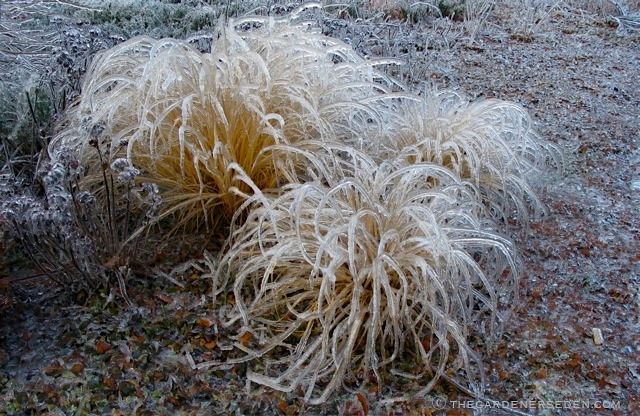 Grasses remain beautiful well into winter. Above, pictured in the entry garden at Ferncliff, fountain grass and side oats look particularly magical in December when coated with ice or snow. Below, the tassels of Miscanthus sinensis, frozen with ice, catch the January light…
Grasses remain beautiful well into winter. Above, pictured in the entry garden at Ferncliff, fountain grass and side oats look particularly magical in December when coated with ice or snow. Below, the tassels of Miscanthus sinensis, frozen with ice, catch the January light…
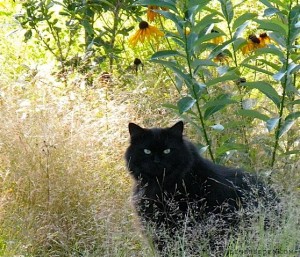 Woo in the native meadow garden with rudbeckia and Deschampsia flexuosa, (hair grass)
Woo in the native meadow garden with rudbeckia and Deschampsia flexuosa, (hair grass)
***
Article and all other photographs â“’ 2009 Michaela at TGE
All content on this site, (with noted exceptions), is the property of The Gardener’s Eden and may not be used or reproduced without prior written consent. Inspired by something you see here? Great! Please give credit where credit is due. It’s a small world and link-love makes for fond friendships. Stealing makes for bad dreams…
Do you enjoy visiting The Gardener’s Eden? You can help support this site by shopping through our affiliate links. A small percentage of any sale originating from The Gardener’s Eden site will go toward web hosting and maintenance costs. Thank you for your support!
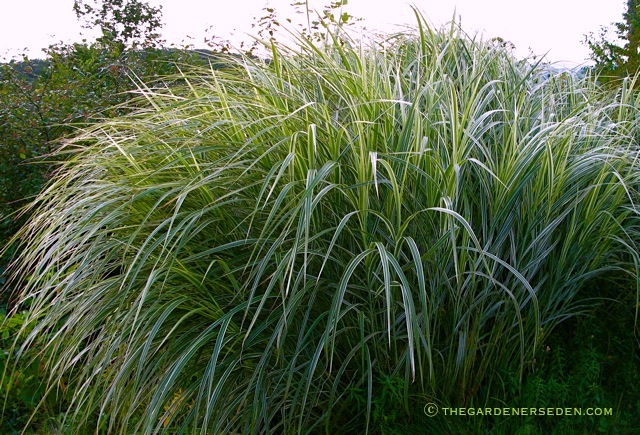
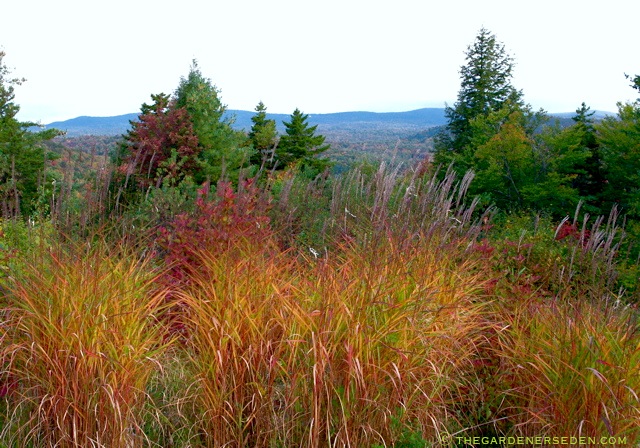
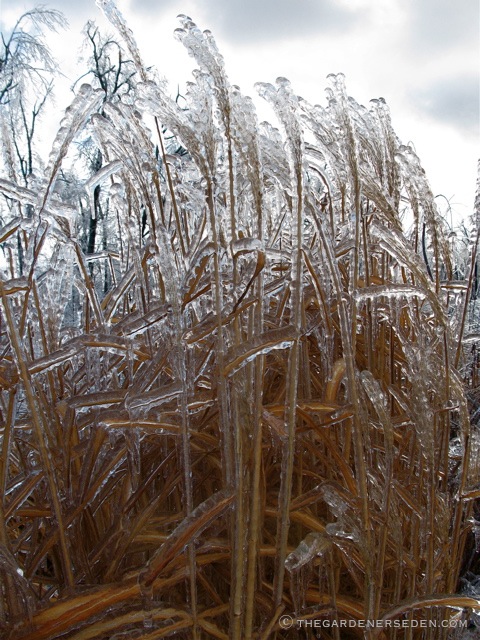

4 Replies to “Autumn and Everything After……. Designing Beautiful Late Season Gardens with Ornamental Grass…”
Comments are closed.